Trees Birds Mammals Fish Amphibians Reptiles
Wild Algarve
Bookshop
Entoloma pleopodium (Bull.) Noordel. - Aromatic Pinkgill
Phylum: Basidiomycota - Class: Agaricomycetes - Order: Agaricales - Family: Entolomataceae
Distribution - Taxonomic History - Etymology - Identification - Culinary Notes - Reference Sources
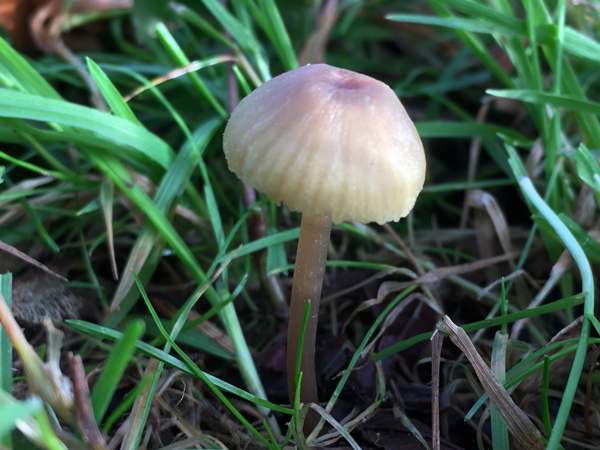
Entoloma pleopodium is a distinctive little pinkgill mushroom that favours rich soil, often in places where Stinging Nettles grow - so beware!
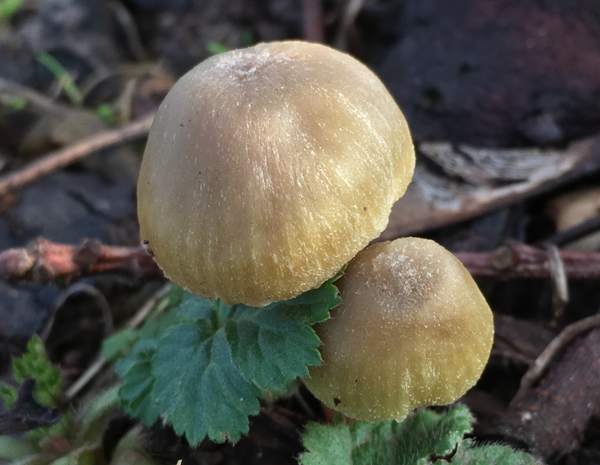
Distribution
The Aromatic Pinkgill is an occasional find in Britain and Ireland; it occurs also throughout much of mainland Europe, from Scandinavia down to the Mediterranean and the Iberian Peninsula.
Taxonomic history
This uncommon mushroom was described scientifically in 1805 by the French mycologist Jean Baptiste Francois Pierre Bulliard, who gave it the name Agaricus pleopodius. (In the early days of fungal taxonomy most gilled mushrooms were placed in the genus Agaricus, which was later broken up into the many other genera that we use today.) It was Dutch mycologist Machiel Evert Noordeloos (b. 1949) who via a 1985 publication established this mushroom's currently-accepted scientific name as Entoloma pleopodium.
Synonyms of Entoloma pleopodium include Agaricus pleopodius Bull., Nolanea pleopodia (Bull.) Gillet, Rhodophyllus pleopodius (Bull.) Quél., and Latzinaea pleopodia (Bull.) Kuntze, Nolanea icterina (Fr.) P. Kumm., Rhodophyllus icterinus (Fr.) Quél., and Entoloma icterinum (Fr.) M.M. Moser.
Etymology
The generic name Entoloma comes from ancient Greek words entos, meaning inner, and lóma, meaning a fringe or a hem. It is a reference to the inrolled margins of many of the mushrooms in this genus.
The specific epithet pleopodium sounds rather like a reference to a lobster (a pleopod), but it probably refers to some superfluous feature of the 'foot' (the stem!).
Identification guide
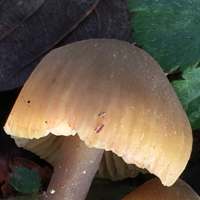 |
Cap
1 to 3.5cm across; initially campanulate or convex becoming flattish often with either a small narrow umbo or a slight central depression; hygrophanous; various shades of yellow-green to olivaceous yellow, frequently with brown or reddish-brown tinges towards the centre; surface smooth and translucently striate. |
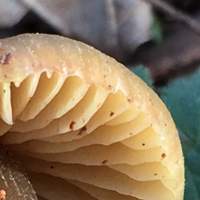 |
Gills
Moderately spaced, adnate, emarginate or almost free; whitish at first, later becoming pink; cheilocystidia absent.
Stem
Cylindrical or tapering slightky towards the apex; 2 to 8cm long and 1 to 5mm diameter, smooth or with scattered fibrils, reddish brown to yellowish brown; no stem ring. |
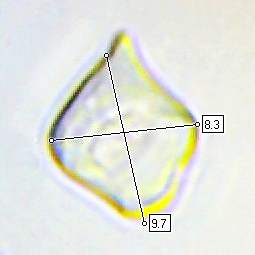 |
Spores
Mostly five- to six-angled (pentagonal to hexagonal) in side view; 8-11 x 6.5-8μm.
Spore print
Brownish pink. |
Odour/taste |
Smell usually stongly aromatic of 'pear drops' or some say of ripe apples; taste unpleasant but not distinctive. |
Habitat & Ecological role |
Saprobic on rich soil, especially on grassy woodland edges with Stinging Nettles Urtica doiica but occasionally also on lawns and in parkland. |
Season |
Fruiting from summer into early winter in Britain and Ireland. |
Similar species |
|
Culinary Notes
Entoloma pleopodium is too rare to be collected for anything but essential research. (It is also thin-fleshed and insubstantial.)
Reference Sources
Fascinated by Fungi, 2nd Edition, Pat O'Reilly 2016, reprinted by Coch-y-bonddu Books in 2022.
Entoloma pleopodium (Bull.) Noordel., Persoonia 12(4): 459 (1985)
Knudsen H., Vesterholt J. (eds) Funga Nordica: agaricoid, boletoid and cyphelloid genera - Nordsvamp, 2008
British Mycological Society (2016). English Names for Fungi
Dictionary of the Fungi; Paul M. Kirk, Paul F. Cannon, David W. Minter and J. A. Stalpers; CABI, 2008
Taxonomic history and synonym information on these pages is drawn from many sources but in particular from the British Mycological Society's GB Checklist of Fungi.
Acknowledgements
This page includes pictures kindly contributed by Simon Harding.
Top of page...
Fascinated by Fungi. Back by popular demand, Pat O'Reilly's best-selling 450-page hardback book is available now. The latest second edition was republished with a sparkling new cover design in September 2022 by Coch-y-Bonddu Books. Full details and copies are available from the publisher's online bookshop...